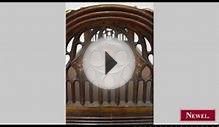
|
York Minster, West Facade.
Gloucester Cathedral - a typical example
Architectural
|
Summary In England during late 12th century, the old style of Romanesque architecture (known as "Norman architecture") was gradually replaced with a new style known as Gothic architecture, emanating from France. This new Gothic style flourished in England from about 1180 until about 1520, and evolved in a similar way to its French counterpart. There are three main periods of English Gothic: (1) "Early English Gothic" (1180-1250). (2) "Decorated Gothic" (1250-1350), separated into the "Geometric" style (125090) and the "Curvilinear" style (12901350). (3) "Perpendicular Gothic" (1350-1520). Like Continental Gothic, the English variety is characterized by its pointed arches, vaulted roofs, flying buttresses, enlarged windows, and spires. Introduced from France, where it first came together in the choir of Abbot Suger's Saint-Denis Basilica north of Paris, dedicated in June 1144. In England, the first large-scale application of English Gothic architecture occurred at Canterbury Cathedral and Westminster Abbey, while a good example of how it evolved naturally from Norman architecture can be seen at Durham Cathedral which has the earliest-known pointed rib vault. Gothic art took root in England some 50 years later than it did in France, but it endured for longer. In fact it continued to flourish in England for a century after Filippo Brunelleschi (1377-1446) designed the dome of Florence Cathedral (1420-36) thus formulating the principles of Renaissance architecture that kickstarted the cultural revolution of the quattrocento. Many of England's medieval cathedrals were built in the Gothic style, but so were numerous castles, palaces, universities and great houses. Although it declined in the sixteenth century, English Gothic reappeared three centuries later during the Gothic Revival, one of the most popular movements of 19th century architecture (1820-1900). Promoted by the Victorian art critic John Ruskin (1819-1900), the Gothic Revival style was exemplified in England by the Houses of Parliament (1840), designed by Charles Barry and AWN Pugin. History and Characteristics Early English Gothic (1180-1250) As mentioned above, Early English Gothic architecture began to replace Norman architecture from about 1180, and lasted until about 1250 when it gave way to "Decorated Gothic". Like the early forms of Gothic on the Continent, the English variety arose out of the efforts of cathedral architects and masons to redistribute the downward and outward thrust of the vault, so as to build higher without the danger of collapse. However, in some respects Early English Gothic cathedrals were significantly "less Gothic" than their French counterparts. For example, they had heavier, thicker walls - not terribly different from the style of Romanesque art of the late 11th century. But the style was characterized above all by the pointed arch (or "lancet"). Pointed arches were employed not merely in wide-span arches such as those covering the nave arcade, but also for doors and windows. One of the best examples of Early English Gothic is Salisbury Cathedral, as it was built over a fairly short period (largely between 1220 to 1258), and (except for its 14th century facade, tower and spire) is relatively uncontaminated by other styles. Other examples include the nave and transept of Wells Cathedral (12251240); the Galilee porch at Ely Cathedral; the transept of Rochester Cathedral, and the south transept at York. For a comparison with French Gothic, see: Notre-Dame Cathedral in Paris (1163-1345) and Chartres Cathedral (1194-1250). Decorated Gothic (1250-1350) The Decorated Period in English Gothic architecture (comprising the Geometric style 125090, followed by the Curvilinear style 12901350) is characterised above all by its window tracery. Increasingly elaborate windows began to appear, subdivided by narrowly spaced parallel mullions (vertical bars of stone), typically up to the point at which the arched top of the window starts. The mullions then spread out and intersect to cover the top part of the window with an intricate mesh of patterns, usually including trefoils and quatrefoils. The two phases of Decorated Gothic (Geometric and Curvilinear) are named after the type of tracery pattern (geometrical or flowing) which dominated at the time. (See also: English Gothic Sculpture of the period.) In addition to tracery, Decorated Gothic interiors characteristically featured tall columns with a more slender and elegant appearance than in previous periods. Vaults became more elaborate, and employed an increasing number of ribs. Initially this was for structural reasons, but then it became a matter of aesthetics. Furthermore, arches become equilateral, and dog-tooth motifs are replaced by the ballflower and a four-leaved flower. Detailed carving reached its peak during the Curvilinear period, with intricately carved windows and capitals, and tracery based on floral patterns as well as the ogee, or S-shaped curve, with its flowing, flamelike shapes. Note: the Decorated style of English Gothic broadly corresponds to... |
RELATED VIDEO




 Jacobethan is the style designation coined in 1933 by John Betjeman to describe the mixed national Renaissance revival style that was made popular in England from the late 1820s, which derived most of its inspiration and its repertory from the English Renaissance...
Jacobethan is the style designation coined in 1933 by John Betjeman to describe the mixed national Renaissance revival style that was made popular in England from the late 1820s, which derived most of its inspiration and its repertory from the English Renaissance...








